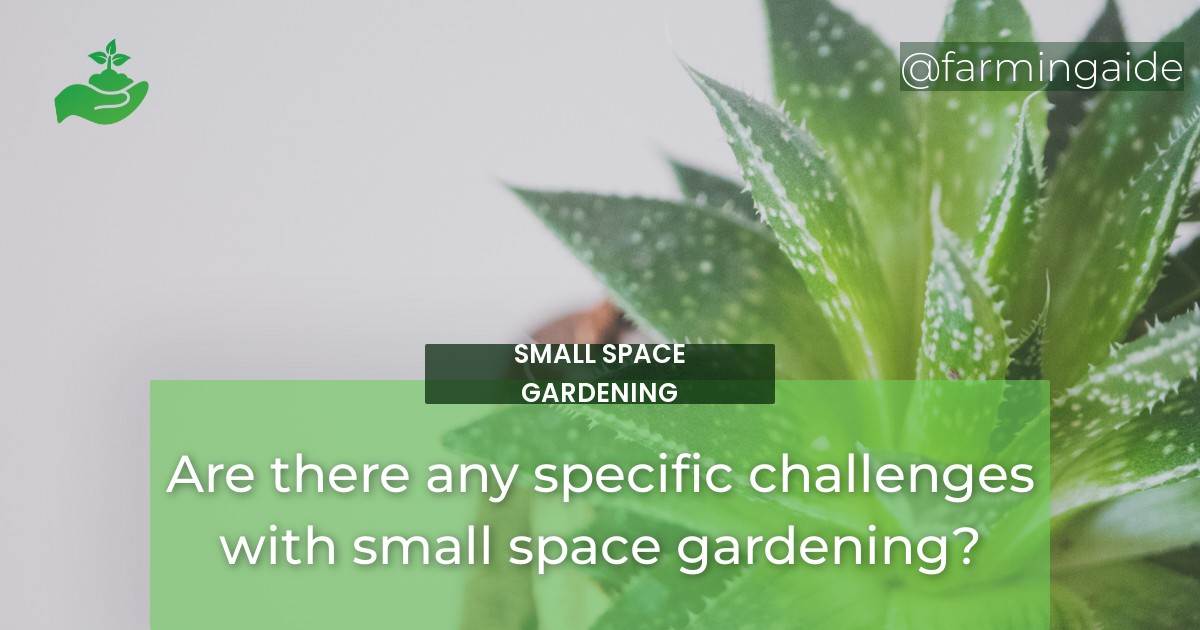Small space gardening is becoming increasingly popular, especially in urban areas where space is limited. Gardening in small areas, however, presents several unique challenges that may be daunting to beginners. Understanding the challenges of small space gardening is essential to overcome them and achieve successful gardening results.
Understanding the Challenges
Limited Space
The limited space available for gardening is one of the major challenges of small space gardening. Urban gardening difficulties often arise due to the lack of space, which can make it challenging to grow a variety of plants.
Solutions:
- Vertical Gardening: This involves growing plants upwards instead of outwards. You can grow plants on trellises, walls, and fences.
- Container Gardening: This involves growing plants in containers such as pots, buckets, and barrels.
Lack of Sunlight
Another common problem in small space gardening is a lack of sufficient sunlight. Most plants require at least six hours of sunlight each day to thrive.
Solutions:
- Container Gardening: Move pots and containers regularly to ensure they receive enough sunlight.
- Hydroponics: Hydroponic systems offer an efficient way to grow plants indoors with artificial light.
Poor Soil Quality
Small space gardening issues may also arise due to poor soil quality. The soil in urban areas is often contaminated with pollutants, making it unsuitable for growing plants.
Solutions:
- Raised Beds: Raised beds offer a way to grow plants above contaminated soil.
- Container Gardening: Use high-quality potting soil in containers to ensure your plants have the right nutrients.
Limited Water Supply
Water is essential for plant growth, and limited water supply can be a challenge in small space gardening, especially during summer when the weather is hot and dry.
Solutions:
- Drip Irrigation: Drip irrigation systems deliver water slowly and directly to the plants’ roots, ensuring minimal water wastage.
- Self-Watering Containers: Self-watering containers have a reservoir that holds water, ensuring the plants have a steady supply of water.
Overcoming the Challenges
Vertical Gardening
Vertical gardening is a practical solution to the limited space available for gardening. It involves growing plants upwards instead of outwards, using trellises, walls, and fences.
Container Gardening
Container gardening is another effective way to garden in small spaces. It involves growing plants in pots, buckets, and barrels.
Hydroponics
Hydroponics is an innovative way to grow plants indoors with artificial light. It involves growing plants in water with added nutrients instead of soil.
Raised Beds
Raised beds offer a way to grow plants above contaminated soil. They also offer better drainage and aeration, allowing plants to grow more effectively.
ALSO READ
Maximizing the Space
Companion Planting
Companion planting involves planting different crops that benefit each other in the same bed or container. It can help maximize the use of limited space and improve yield.
Crop Rotation
Crop rotation involves changing the location of plants each season to minimize soil-borne diseases and pests, ensuring optimal soil health.
Intensive Planting
Intensive planting involves planting crops closer together than usual, maximizing the use of limited space. It can help increase yield and minimize weed growth.
Other Considerations
Pest and Disease Control
Small space gardening can attract pests and diseases, making it essential to take measures to control them.
Solutions:
- Natural Pest Control: Use natural pest control techniques such as companion planting and beneficial insects.
- Crop Rotation: Crop rotation can help minimize soil-borne diseases and pests.
Proper Plant Selection
Choosing the right plants for your small space garden can make all the difference. Consider factors such as sunlight, space, and soil quality when selecting plants.
Weather and Climate Adaptation
Small space gardening requires adapting to different weather and climate conditions, especially in urban areas. Be prepared for changes in weather patterns and adjust your gardening techniques accordingly.
ALSO READ
Conclusion
Gardening in small spaces presents several challenges, but with the right techniques and tools, anyone can achieve successful gardening results. By understanding the challenges of small space gardening, you can proactively take measures to overcome them and maximize your limited space. Don’t be discouraged by the challenges; instead, be encouraged to try small space gardening and enjoy the benefits of growing your food.


